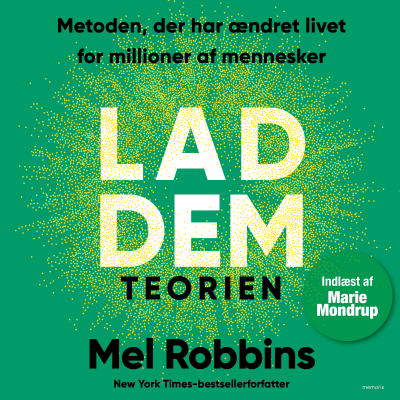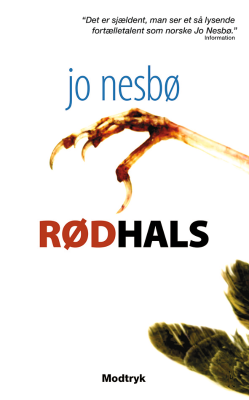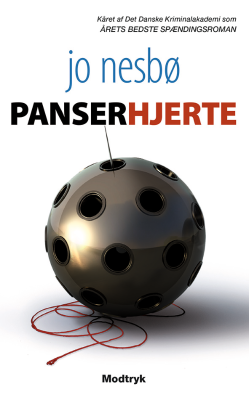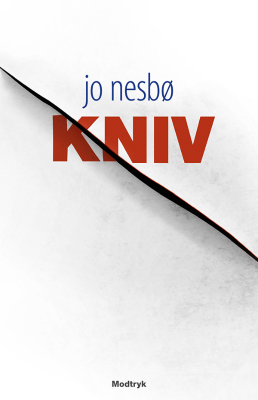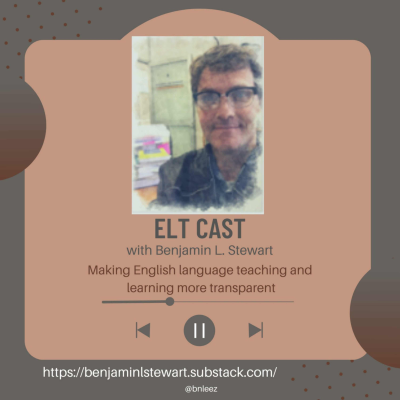
ELT Cast
engelsk
Kultur & fritid
Begrænset tilbud
1 måned kun 9 kr.
Derefter 99 kr. / månedOpsig når som helst.
- 20 lydbogstimer pr. måned
- Podcasts kun på Podimo
- Gratis podcasts
Læs mere ELT Cast
ELT Cast is an educational podcast of shared teaching and learning practices and perspectives as an English-as-a-foreign-language teacher trainer. Topics include 1) becoming a more effective, efficient, and engaging communicator of the English language; 2) discussing how languages are learned; 3) discussing educational theory; and 4) discussing teaching practice. This podcast is for informational and entertainment purposes only. The opinions expressed here are my personal views and do not represent the official position or endorsement of any other entity. benjaminlstewart.substack.com
Alle episoder
134 episoderThesis Seminar Recap Week 15
Executive Summary: This document summarizes key instructions and guidelines provided for the completion of the first draft of the thesis paper and preparation for the mock presentations. The sources emphasize adherence to formatting requirements (APA 7th edition), content guidelines for specific sections (Abstract, Introduction, Literature Review, Method, Results/Discussion, Conclusion, Appendices, References), and preparation strategies for the mock presentations, including content, delivery, and technical aspects. Key themes include attention to detail in formatting, summarizing the paper effectively, and practicing delivery and anticipating questions for the presentation. Key Themes and Ideas: * Hard Copy Draft Review: Students are required to submit a hard copy of their first completed draft. A quick self-review in groups is encouraged, focusing on specific formatting elements. * Headings: Check that all headings (except in the method section) have 6 to 12 words. Main words should be capitalized. No punctuation should be at the end of any heading. Method section headings (Participants, Instruments, Procedure, Data Analysis) can be shorter. * Page Breaks: Specific pages should be on their own page: Title page, Authorization page, Abstract, Table of Contents, Figures/Tables (if applicable), and each Appendix. The body of the paper (Literature Review through the Conclusion paragraph) should have no page breaks. * Spacing: The entire paper should be double-spaced, with no extra space between paragraphs, headings, and text. References are an exception, with single spacing within the reference and double spacing between references. * Indentation: Each paragraph, except for the Abstract, should have a half-inch indentation. * Paragraph Count: The Abstract, Participants, Instruments, Procedure, and Data Analysis sections should each consist of only one paragraph. The final paragraph of the paper is considered the Conclusion paragraph and does not require a separate "Conclusion" heading. * Appendix Formatting: Each appendix should start on a new page with a Level 1 heading (e.g., "Appendix A") at the very top line, followed by a Level 2 heading for the appendix title. * Title Recommendations: The instructor suggests using ChatGPT to generate title ideas now that the paper is mostly complete. * If the title is longer than one line, force a return to distribute words more or less equally across two lines. * Single-space the title. * Improving Writing (Verb Usage): Students are encouraged to review their paper for overuse of the verbs "to have," "to be," and "to make" (as lexical verbs). While not forbidden, excessive use may indicate areas for improvement by substituting more dynamic verbs, often converting nouns into verbs. The instructor provides an example of how to rewrite sentences to be more concise and dynamic. * Mock Presentation Structure and Timing: The mock presentation is 20 minutes long with a 10-minute Q&A. The entire class scheduled for a specific day is expected to observe all presentations on that day. * Suggested Slide Order: Title slide, Problem and Purpose, Literature Review (multiple slides), Method, Results and Discussion (multiple slides), Conclusions, Thank You. * Approximate Timing: Problem and Purpose (30 seconds to 1 minute), Literature Review (approximately 8 minutes), Method (approximately 2 minutes), Results and Discussion (approximately 9-10 minutes). * Presentation Content: Present only the essential information that directly relates to the research questions and analyzed data. Do not attempt to present everything from the written paper due to time constraints. * Mock Presentation Delivery and Technical Aspects: * Preparation: Practice the presentation, ideally recording oneself and timing each section. Consider practicing in front of someone. * Slides: Slides are meant to support the speaker, not to be read directly. They should function as "big note cards" with key points or ideas. Each slide should focus on one main point and include a heading. Avoid paragraphs and excessive text on slides. * Visuals: Make slides visually appealing but not distracting. Use visuals like graphs, charts, tables, and images from the paper, simplifying or modifying them for the presentation. Use no more than three different font styles and sizes, and choose easy-to-read fonts. Avoid animations and complex color schemes that might reduce contrast. * Technology: Coordinate with classmates to use one computer for presentations on a given day. Test equipment beforehand, turn off automatic updates, and ensure the computer is fully charged and doesn't go to sleep. Have a backup of the presentation file (e.g., on a USB drive in addition to the computer). * Delivery: Focus on the message, not personal nervousness. Maintain eye contact with the audience, specifically the examiners during the final defense, distributing attention among them. Bring a water bottle. * Anticipate Questions: Prepare for potential questions, including definitions of key terms used in the study. * Final Oral Defense Considerations: * Similar guidelines to the mock presentation, but attendance is by invitation only (family, friends, classmates). * Coordinate bringing refreshments for the examiners. * Arrive at least 30 minutes early with guests. * Maintain eye contact, especially with examiners. * No microphone is expected to be needed; speak loudly and project. * Present from the stage or on the floor in front of the stage, based on comfort. * Paper Submission: Submit three hard copies of the first completed draft. Confirm that the version in Microsoft Teams is the same as the hard copy. The final paper (Word document and three hard copies) is due officially one week before the scheduled presentation. Quotes: * "Make sure that the headings all of the headings have 6 to 12 words except for the headings in the method section." * "Check each heading to make sure that the main words are capitalized." * "Finally, check at the end of each heading. No punctuation, no period, no colon, no. Nothing." * "The body of the paper, there are no page brakes." * "Make sure each appendix has a page break and appears at the very top line." * "Make sure that each paragraph with the exception of the abstract has a half of an inch indentation." * "Look at the abstracts. Each section of the method and your conclusion to make sure you only have one paragraph." * "Today, I'm going to receive your uh hard copies of your first completed draft. This is an important milestone, right?" * "Today I want to spend just a few minutes very quickly all of us taking a look at your document, making a few notes very very quick." * "I would recommend trying and experimenting with chatt to give you some ideas of titles now that your paper has been completed." * "If your title extends longer than one line... force a return... single space the title." * "I want you to see how many times you're using three birds. to have, to be, to make." * "The problem in general is when we're using a bunch of times these verbs voice passive and there is there are. The problem is we have a lot of nouns that could be converted to a verb." * "We need to be prepared on Monday, well, whenever you're presenting, for a 20 minute presentation with a 10 minute question and answer." * "Remember your presentation is there to support what you are saying, not vice versa." * "Think of the the PowerPoint presentation the slides as big cards note cards." * "We don't want any distractions, right? It's a distraction when you're speaking and somebody's coming in and out." * "Maintain eye contact... try to connect to those examiners because they're the ones that are going to give you the grades." Source 2: Excerpts from "TS Recap 15.mp4" This source provides a recap of Week 15 for Thesis Seminar, focusing on the requirements for the first completed draft of the thesis paper due the same week. Key Themes and Ideas: * First Completed Draft Requirements: The first completed draft is due as a hard copy. Students should refer to the course guidelines for detailed requirements, including approximate word counts. * Introduction Paragraph: Should start with a hook, provide context for the problem, and end with the thesis statement. * Transitional Paragraph: Should restate the thesis statement, summarize the problem, introduce the research questions, and conclude with a closing statement. * Conclusion Paragraph (End of Results and Discussion): Approximately 250 words. Should begin by restating and rewording the thesis statement, discuss study limitations and significance, suggest future research, and end with a closing statement. * Abstract: Should be on its own page, follow the provided template, and be one paragraph of approximately 250 words. It should summarize the entire paper: problem, method (participants, data collection, analysis), findings, and conclusions/implications. It serves as a snapshot for readers to decide if they want to read the full paper. * Formatting (Reinforced):Title: 6 to 12 words. * Spacing: Double-spaced throughout the paper (except references). * Alignment: Left-justified. * Indentation: 0.5-inch indentation for all paragraphs except the Abstract. * References: Adhere to APA 7th edition. Use a hanging indent (French indentation). Single-space within each reference and double-space between references. * Appendices: Each appendix on a new page with a Level 1 heading ("Appendix A," etc.) and a Level 2 heading for the title. Use the specified font styles (Level 1 APA, Level 2 APA, etc.) for headings. * Table of Contents: Should be updatable based on correctly formatted headings. * Approximate Word Counts: Provides word count guidelines for major sections: Literature Review (approx. 2250 words), Results and Discussion (approx. 2250 words), Method (approx. 500 words, divided among Participants, Instruments and Procedure, Data Analysis). Quotes: * "This week, we need to finish our first draft. And today, I want to talk about what should be included in your completed first draft. Uh a hard copy that you're to turn in by noon this Thursday, May 22nd, 2025." * "Make sure that you've uh reviewed the course guidelines that are available in Microsoft Teams... it includes a section with approximate word counts." * "Your paper should include an introductory or an introduction paragraph... make sure that the uh the introduction paragraph begins with a hook. It offers the context of the problem and it concludes by stating your thesis statement." * "The conclusion paragraph to end your results and discussion section should be approximately 250 words and begin again with your thesis statement restated and rewarded." * "After restating your thesis statement, you can talk about um any limitations that you find... include the significance of your study and also future research." * "The abstract should be on its own page... Should be one paragraph, approximately 250 words, and should state basically summarize uh your whole paper." * "Think of the abstract as a kind of a snapshot of your whole paper." * "Make sure you have a title of your paper, 6 to 12 words." * "Your whole paper should be double spaced, left justified." * "All paragraphs should have a uh 0.5 in indentation with the exception of the abstract." * "Double check your list of references making sure that they adhere to APA 7th edition." * "Make sure you using a French indentation or a uh a hanging indent." * "Each appendix should have a level one heading that states which appendix it is... And then as a level two, I would include the title of the of the appendix." Conclusion: Both sources provide essential guidance for completing the thesis paper draft and preparing for the mock presentations. The first source delves deeply into specific formatting checks and detailed presentation strategies, while the second source provides a concise overview of the key components and formatting requirements for the written draft. Students are strongly encouraged to meticulously review their drafts against the provided guidelines, practice their presentations thoroughly, and anticipate questions to ensure a successful mock presentation and final defense. Attention to detail in both the written document and the presentation delivery is paramount. Recap for Week 15 Configuring tables and figures This is a public episode. If you would like to discuss this with other subscribers or get access to bonus episodes, visit benjaminlstewart.substack.com [https://benjaminlstewart.substack.com?utm_medium=podcast&utm_campaign=CTA_1]
Analyzing Qualitative Data
Notes to the talk [https://benjaminlstewart.notion.site/Analyzing-Qualitative-Data-1d14b19081c280f08b91da7c88094908?pvs=4] Here is a brief that summarizes the main themes and important ideas discussed in the provided sources: an audio recording ("Data Analysis_042025.mp3") of a thesis seminar session and excerpts from a document titled "Making Sense of Stories: Analyzing Qualitative Data in ELT Teacher Training." The primary focus is on data analysis techniques, particularly qualitative coding, triangulation, and the potential for incorporating quantitative elements. I. Key Themes and Important Ideas: A. Importance of Completing Data Collection Before Analysis: * The seminar leader emphasizes that data analysis should only begin after all data collection is complete. "Today's discussion is about data analysis. All of you have collected or very close to having completed uh collecting all of your data and this is an important requirement to continue the process of data analysis... If you are still trying to collect some information, know that what we talk about today uh you need to wait." * Starting analysis prematurely, before all data is gathered, is considered a "mistake." B. Understanding the Purpose of Data Analysis: * Data analysis is crucial for understanding the collected data and determining what is relevant and significant to report in the results and discussion sections of the thesis. * It helps researchers move from a large amount of raw data to focused and insightful findings. "Think of it like this. All of you are at this point, you've collected, if not all, most of your data. So you have all this data that you've collected... Ahora con todo esta información which data is not relevant... So you're going to then include this circle represents now only the information that relates to your research questions... Now from your data analysis... you're going to then figure out ok of all this information that now is relevant to my study, what is worth What is including in mys discussion?" * Not all relevant data needs to be reported; the analysis helps identify the most "important, surprising, insightful, interesting" findings. C. The Concept and Importance of Triangulation: * Triangulation involves bringing together different data sources (e.g., interviews, observations, documents) to gain a more comprehensive understanding of the research topic. * It allows for comparison between what participants say they do/believe, what they actually do (observed), and their planning/reflection processes. "Think of this if it helps to look at it like this. Your um your information here is allowing you to compare different things. For example, what people say they do or believe... What do they actually do? Well, to know that, what do we have to do? Have to observe." * The seminar leader stresses the importance of having sufficient data to triangulate and encourages participants to address any concerns about this. "If anybody today right now has concerns about whether or not you have the types of data to allow you to triangulate, we need to have a discussion today." * The "Making Sense of Stories" document provides specific examples of triangulation in ELT teacher training research, such as comparing planned instructions in lesson plans with delivered instructions observed in the classroom. "Compare the planned instructions (document) with the delivered instructions (observation). Were planned ICQs actually used?" D. Introduction to Qualitative Coding: * Qualitative coding is defined as a systematic process of labeling and organizing segments of text data (transcriptions, observation notes, documents) to identify patterns, themes, and concepts relevant to the research questions. "The process of coding is the process of labeling text. Coding is a systematic way to make sense of rich, complex, and often messy reality of language." * All audio and video data must be transcribed into text before coding. Microsoft Word Online's transcription feature is suggested as a tool. * The coding process involves identifying text segments (words, phrases, sentences, paragraphs) that relate to the research questions and assigning specific labels or "codes" to them. "You're coding things that relate to your research questions... Porque estamos en este proceso distinguendo, tenemos que distinguir qué sirve para nuestro estudio, qué no sirve, vamos a dejarlo fuera." E. Levels of Qualitative Coding: * The seminar introduces a three-level inductive coding approach: * Level One (Initial Codes): Creating very specific labels directly from the text, the literature review, or using in vivo codes (participant's exact words). "The first you create... the code, the label comes from your literature review... Using a label a code directly. If anx dijo eso... Tú puedes seleccionar esta frase. ¿Qué lebo puedes poner? Anxious, anxiety." * Level Two (Categories): Grouping the initial, specific codes into broader, more conceptual categories. "When we finish, you should have a long list of codes. And so I would do it in something like Excel... Les Segundo nivel es ordenar. Este grupo de códigos initial codes va aquí y voy a crear otra código. Puede ser como en category que representen todos sus códigos que son más específicos." * Level Three (Themes): Grouping the categories into overarching themes that provide a higher level of understanding and relate directly to the research questions. "Level three, yo voy a poner este themes. Ya vamos a tener categorías, ¿verdad? Cada categoría va a tener sus initial codes. ¿Qué hicimos? ¿Qué hacemos para este nivel level? Categoriz group these categories into these yes." * The "Making Sense of Stories" document also describes a similar iterative coding process, including immersion, initial/open coding, developing a codebook, focused/axial coding, and identifying themes/selective coding. F. The Codebook: * The outcome of the coding process is a codebook, which is a crucial part of the methodology section of the thesis. * The codebook will list all the codes used, potentially organized by categories and themes, and may include definitions and examples. "Cuando terminen, you're going to have a codebook... you're going to include your codebook that's going to include all of the codes that you used and it's going to be an outline como esema in word. categories initial codes." * The methodology section will describe the coding process and reference the codebook in the appendix. G. Incorporating Frequencies and Duration (Quantitative Elements): * The seminar leader emphasizes that qualitative data can be converted into quantitative data (frequencies, duration) for analysis. "How many of you think you'll need to analyze because we can convert qualitative information into quantitative information..." * This involves counting the occurrences of specific codes or measuring the length of certain events (e.g., teacher-student exchanges, use of relaxation techniques). * Examples discussed include tracking the frequency of positive/negative reinforcement, scaffolding, relaxation techniques, and the duration of collaborative work or interactions with specific students. * The "Making Sense of Stories" document provides detailed examples of how to quantify qualitative data by defining observable behaviors, developing coding rules, and using presence/absence or frequency counts in spreadsheets. H. Relationship Between Analysis and Reporting: * The analysis process directly informs what will be reported in the results and discussion sections. "We don't know what to write in the results and discussion until we understand the data. To understand the data, we need to analyze the data." * The evidence presented in the results section will often consist of direct quotes from the data that have been coded. * The analysis (coding, identifying themes, considering frequencies) helps determine the structure and content of the results and discussion. I. Openness to Modifying Research Questions: * Based on the initial findings during data analysis, it may be necessary to slightly modify the research questions to better align with the emerging answers. "It's very common at this point as you are analyzing your data and when you come back on May 5th that in some cases we may need to modify slightly your research question." * However, any modifications should remain within the scope of the literature review. J. Timeline and Expectations: * Participants are expected to begin the data analysis process (coding, considering frequencies) during the break before the next group session on May 5th. * This analysis is considered a crucial step that will significantly impact the quality of the thesis. * The final thesis paper is due on May 22nd, followed by mock presentations starting on May 26th and oral defenses. K. Utilizing Large Language Models (LLMs) as Research Assistants: * The "Making Sense of Stories" document introduces the potential of using LLMs to assist with qualitative data analysis. * LLMs can help with generating initial coding ideas, applying preliminary coding schemes, calculating frequencies of codes, and analyzing Likert scale questionnaires. * However, it is strongly emphasized that researchers must critically assess, validate, and cross-reference the output from LLMs to avoid bias and inaccuracies. LLMs should be seen as tools for augmentation, not replacements for rigorous methodological practices. II. Notable Quotes: * "Today's discussion is about data analysis. All of you have collected or very close to having completed uh collecting all of your data and this is an important requirement to continue the process of data analysis..." * "Please don't make that mistake. Okay. Today what we're going to be talking about is a process of analyzing qualitative information, but it's also a way to for you to start thinking about what you're going to report." * "This concept of triangulation is going to be very important in today's discussion for data analysis. Think of this if it helps to look at it like this. Your um your information here is allowing you to compare different things." * "Qualitative coding is the process of systematically identifying, labeling, and organizing segments of your data to discover patterns, themes, concepts, and relationships relevant to your research questions." * "Coding is simply labeling. It's giving a name to the text that you have." * "Repito, los códigos tien que ser super específico. Si comenzamos demasiado general, we don't have any place to go if we start to general." * "All qualitative can be converted to quantitative data and vice versa. When conducting qualitative data, you might find it useful to convert data to quantitative data and then analyze it." * "Correlation does NOT imply causation!" III. Implications for Thesis Work: * Participants need to prioritize transcribing their audio/video data and engaging in the initial levels of qualitative coding. * They should actively think about how triangulation will be achieved in their studies using their collected data sources. * Considering potential quantitative analysis (frequencies, duration) can add another layer of insight to their findings. * Developing a detailed and well-defined codebook is essential for a rigorous and transparent analysis process. * Researchers should remain flexible and open to refining their research questions based on the initial insights from the data analysis. * While LLMs can be helpful tools, they should be used judiciously and with critical evaluation. This briefing document provides a comprehensive overview of the key aspects of data analysis discussed in the provided sources, highlighting the importance of systematic qualitative methods and the potential for integrating quantitative elements in ELT teacher training research. Participants are encouraged to begin their analysis promptly and seek clarification on any doubts. Review Quiz * According to the speaker, what is the primary focus of today's session? Why is it being addressed at this particular point in the semester? * Explain the significance of triangulation in qualitative data analysis as described in the audio. Provide an example of how triangulation could be applied using different data sources mentioned. * Summarize the three levels of coding for qualitative data analysis discussed in the audio. What is the purpose of moving through these levels? * Describe what a codebook is and when it should be developed in the data analysis process. What key information does it contain? * Explain the difference between creating codes and using in vivo codes. Provide an example of each based on the provided material. * Why does the speaker emphasize the importance of transcribing all audio and video data to text before beginning the coding process? * What is the speaker's advice regarding modifying research questions at this stage of the thesis process? What important caveat does they mention? * Describe at least three examples from the audio of how qualitative data can be converted and analyzed using frequencies or duration. * According to the speaker, what constitutes the "results and discussion" section of the thesis paper in relation to the analyzed data? How does this differ from the literature review? * What reminders were given regarding the assessment components and attendance policy for the thesis seminar? Quiz Answer Key * The primary focus of today's session is data analysis, specifically for qualitative information. This is being addressed now because students have either completed or are very close to completing their data collection, which is a necessary prerequisite for starting the analysis process. * Triangulation is the process of bringing together and comparing information from different data sources (e.g., interviews, observations, documents) to gain a more nuanced and credible understanding of the research topic. For example, a researcher might compare a teacher's stated beliefs about differentiated instruction in an interview with their observed teaching practices and relevant lesson plans to see if these different sources of information align. * The three levels of coding are: (1) Initial/Level One Coding, which involves assigning specific labels or codes to segments of text; (2) Level Two Coding, where initial codes are grouped into broader categories; and (3) Level Three Coding, where categories are further grouped into overarching themes. The purpose of moving through these levels is to move from specific data points to more general analytical insights and patterns. * A codebook is a central document that is developed as the researcher codes their data. It lists all the codes being used, provides a clear definition for each code, outlines inclusion and exclusion criteria for applying the code, and often includes example snippets from the data that illustrate the code. It ensures consistency in the coding process. * Creating codes involves the researcher developing labels for segments of text based on their understanding of the data and research questions, potentially drawing from the literature review. Using in vivo codes involves using the exact words or phrases spoken by the participants as the codes themselves. For example, in the teacher interview snippet, "grammar mistake" is an in vivo code, while "delayed correction" is a created code. * The speaker emphasizes transcribing all audio and video data to text because the process of coding, which involves identifying and labeling segments of data, is primarily applied to text. Therefore, to analyze non-textual data in this way, it must first be converted into a textual format. * The speaker advises students to be open to slightly modifying their research questions based on the initial findings from the data analysis. However, they caution that any modifications should still align with the original literature review and the overall purpose of the research. * Examples of converting qualitative data to quantitative for analysis include: tracking the frequency of positive and negative reinforcement used by a teacher during a lesson; measuring the duration of student-teacher interactions; and counting the number of times a specific vocabulary strategy is implemented in a classroom. * The "results and discussion" section of the thesis paper primarily consists of the analyzed data, presented as evidence (results), and the researcher's interpretation and explanation of these findings in relation to the research questions and existing literature (discussion). This differs from the literature review, which presents findings from previous studies to provide context for the current research. * The speaker reminded students that their tutoring grade only makes up 40% of their final thesis seminar grade, with the oral defense and written thesis evaluation contributing the remaining 60%. They also reiterated the attendance policy, where missing a tutoring session equates to five absences, and exceeding three missed sessions may require taking an extraordinary exam. Essay Format Questions * Discuss the role of data analysis as a crucial bridge between data collection and the reporting of findings in qualitative research. Using examples from the provided audio, explain why skipping the data analysis stage can lead to significant challenges in the thesis writing process. * Critically evaluate the concept of triangulation in qualitative research, drawing on the examples and explanations provided in the sources. Discuss the strengths and potential limitations of using multiple data sources to enhance the credibility and depth of research findings in ELT teacher training. * Explain the three-level coding process for qualitative data analysis presented in the audio, emphasizing the importance of specificity in initial coding and the subsequent development of categories and themes. How does this systematic approach contribute to making sense of complex qualitative data? * Considering the information provided on analyzing frequencies and duration in qualitative data, discuss the value of incorporating quantitative elements into a primarily qualitative study. Provide specific examples from the audio of how this mixed-methods approach can enrich the analysis and provide additional insights in ELT research. * Reflect on the advice given regarding the iterative nature of qualitative research, including the potential need to modify research questions after initial data analysis. Discuss the importance of maintaining an open mind and flexibility throughout the research process while ensuring alignment with the existing literature review and overall research focus. Glossary of Key Terms * Coding (Qualitative): The process of systematically identifying, labeling, and organizing segments of qualitative data (text, audio transcripts, observation notes) to discover patterns, themes, concepts, and relationships relevant to the research questions. * Triangulation: The use of multiple data sources, methods, investigators, or theories to provide a more comprehensive and nuanced understanding of a research phenomenon, enhancing the credibility and validity of the findings. * Codebook: A central document that lists all the codes used in a qualitative study, along with their definitions, inclusion and exclusion criteria, and sometimes example data excerpts. It serves as a guide for consistent coding. * In Vivo Code: A type of code that uses the exact words or phrases spoken by the participants as the label for a segment of data. * Initial Coding (Open Coding/Level One Coding): The first stage of qualitative data analysis where researchers go through the data and assign preliminary, descriptive codes to segments of text, often staying close to the data itself. * Focused Coding (Axial Coding/Level Two Coding): A later stage of qualitative data analysis where initial codes are reviewed, refined, combined, and grouped into broader categories based on their relationships and patterns. * Thematic Analysis (Selective Coding/Level Three Coding): The process of identifying overarching themes or central ideas that emerge from the categories developed during focused coding, which help to answer the research questions. * Frequency Analysis: A method of quantitative data analysis that involves counting how often specific codes, behaviors, or events occur within the data. * Duration Analysis: A method of quantitative data analysis that involves measuring the length of time that specific events or interactions last within the data. * Transcription: The process of converting audio or video recordings into written text. * Likert Scale: A psychometric scale commonly involved in research that employs questionnaires. It is the most widely used approach to scaling responses in survey research, such that the term (or equivalently likert-type scale) is often used interchangeably with rating scale, although there are other types of rating scales. * Inductive Approach: A research approach that starts with specific observations and data, then moves towards identifying broader patterns, themes, and theories. The coding process described is largely inductive. * Deductive Approach: A research approach that starts with a general theory or hypothesis and then gathers data to test or confirm it. * Research Question: A specific inquiry that the research aims to answer. It guides the data collection and analysis processes. * Literature Review: A comprehensive summary and analysis of existing scholarly literature relevant to the research topic, providing context and identifying gaps in knowledge. * Methodology: The section of a research paper that describes the methods used to collect and analyze data. The coding process and codebook would be described in this section. * Results and Discussion: The section of a research paper where the findings of the data analysis are presented (results) and interpreted in relation to the research questions and existing literature (discussion). * Assessment (Thesis Seminar): The evaluation of a student's work in the thesis seminar, which includes the tutor's grading (40%), the oral defense (20%), and the evaluation of the written thesis (40%). * Oral Defense: A formal presentation of the completed thesis to a panel of examiners, who then ask questions about the research. This is a public episode. If you would like to discuss this with other subscribers or get access to bonus episodes, visit benjaminlstewart.substack.com [https://benjaminlstewart.substack.com?utm_medium=podcast&utm_campaign=CTA_1]
Thesis Seminar Recap #9
The tutoring sessions across the provided excerpts consistently focused on guiding students through the crucial data collection phase of their thesis research. Several overarching themes and pieces of advice emerged: * Emphasis on Triangulation: A fundamental principle emphasized in almost every session was the importance of collecting data from multiple sources: observations, interviews, and documents [e.g., 28, 63, 166]. This triangulation is essential for robust and credible findings. * Alignment with Research Questions and Literature Review: Students were repeatedly reminded to ensure that their data collection efforts were directly aligned with their specific research questions [e.g., 50, 63, 153] and grounded in their literature review [e.g., 75, 111, 160]. They were advised to revisit their literature reviews, identify key terms and concepts [e.g., 66, 111, 160], and use these to guide their observations and interview questions [e.g., 75, 114]. * Strategic Data Collection: The tutors stressed the need for a systematic approach to data collection. This involved planning and conducting focused interviews [e.g., 54, 114], taking detailed observation notes [e.g., 65, 71], and actively pursuing relevant documents [e.g., 28, 32, 63, 74, 166] such as lesson plans, syllabi, and student work. * Iterative Process and Flexibility: Data collection was presented as an iterative process of collecting, analyzing, and adapting [e.g., 52, 171]. Students were encouraged to review their collected data regularly to identify gaps, refine interview questions, and adjust their observation focus. Flexibility and proactive problem-solving were also emphasized [e.g., 104, 173]. * Time Management and Deadlines: With the April 16th deadline for data collection approaching, effective time management and maximizing observation opportunities were consistently highlighted [e.g., 37, 104, 116, 159]. * Preparation for Analysis and Writing: While the primary focus was on data collection, the tutors also provided preliminary guidance on preparing for data analysis (e.g., considering coding) and starting to think about the structure of the method section [e.g., 147, 148] and future writing stages [e.g., 150]. * Utilizing Feedback and Resources: Students were directed to utilize the feedback provided during tutoring sessions [e.g., 129, 156], review recap videos [e.g., 38, 57, 138, 152, 174], and explore resources like Notebook LM for summarizing and gaining new perspectives on their work [e.g., 39, 57, 138, 152, 175]. * Importance of Appendix: Students were instructed to include blank copies of their research instruments (consent forms, interview guides, observation sheets) in the appendix of their thesis document [e.g., 75, 106, 118, 140, 161]. Insights for Proceeding Further During the Next Week (Concluding April 16, 2025): Given that the data collection phase is nearing its end (April 16th), students should prioritize the following actions based on the recurring advice from their tutoring sessions: * Finalize Data Collection: This is the last full week for collecting data before the suggested cut-off around April 11th or the firm deadline of April 16th. Students must maximize their remaining observation hours and conduct any planned final interviews [e.g., 37, 104, 159]. Proactive communication with teachers to schedule and confirm these sessions is crucial [e.g., 157, 173]. * Secure Outstanding Documents: Any pending documents (lesson plans, syllabi, worksheets, etc.) are vital for triangulation. Students should make a concerted effort to obtain these materials this week [e.g., 74, 126, 168], following up with teachers and school administrators as needed [e.g., 169, 173], while being mindful of their time and communication preferences. * Review and Consolidate Collected Data: Students should dedicate time to review all the data they have gathered so far (observation notes, interview transcripts or notes, and documents) [e.g., 52, 170]. This review will help them identify any remaining gaps in their data, ensure they have sufficient information to address their research questions, and potentially refine their focus for any final data collection activities. * Reflect on Alignment with Research Questions and Literature: As they review their data, students should actively reflect on how the collected information aligns with their research questions and the key concepts discussed in their literature review [e.g., 75, 160]. Noting these connections will be essential for the analysis phase. If they identify areas where the data seems inconsistent with their theoretical framework, they should make note of this for further exploration in their analysis. * Organize and Prepare for Analysis: While formal coding might begin later, students can start organizing their data in a systematic way (e.g., by research question, by participant, by theme). Reviewing the resources on coding mentioned in some sessions [e.g., 22, 24, 158] might be beneficial to start thinking about potential analytical approaches. * Finalize Appendix Items: Ensure that the appendix section of their thesis document includes blank copies of all the instruments used (informed consent, interview guides, observation sheets) in a clear and organized manner [e.g., 75, 106, 118, 140, 161]. * Utilize Available Feedback: Students should take the time to review any recent feedback received from their tutors, especially regarding writing quality and data collection strategies [e.g., 41, 129, 176]. Implementing relevant suggestions can improve their work and prepare them for the next stages. * Prepare for the April 16th Whole Group Session: Keeping in mind that the April 16th session may focus on data analysis and potentially the method section [e.g., 22, 24, 117, 147, 158], students should come prepared with a good understanding of the data they have collected and any initial thoughts on how they might analyze it. By focusing on these key actions in the final week of their primary data collection period, students can position themselves well for the subsequent stages of analysis and writing. This is a public episode. If you would like to discuss this with other subscribers or get access to bonus episodes, visit benjaminlstewart.substack.com [https://benjaminlstewart.substack.com?utm_medium=podcast&utm_campaign=CTA_1]
Thesis Seminar Recap 8
Thesis Seminar [https://benjaminlstewart.substack.com/p/thesis-seminar-2025] Frequently Asked Questions about Thesis Seminar - Week 8 Recap 1. What should Thesis Seminar students be focused on as they move into week 9 (following March 24th, 2025)? By this stage, students should be actively engaged in data collection across various methods, including gathering documents and content, conducting interviews, facilitating focus groups and stimulated recall sessions, and performing classroom observations with detailed field notes and recordings. A primary focus should be ensuring that the collected data directly addresses their research questions and identifying any gaps in the data that might require further collection through additional documents, interviews, or observations. 2. What resources are being provided to students to support their thesis work? Students will receive links to two primary AI-powered resources: Notebook LM and a podcast. Notebook LM is designed to provide AI-generated feedback based on the student's literature review, tutoring session summaries, and recordings. The podcast features an AI-generated discussion about the student's study, offering an external perspective on their work. Additionally, students will receive documents outlining briefing information, a timeline, and proposed options for presenting their findings later in the thesis process. 3. How should students utilize the Notebook LM resource? The left-hand column of Notebook LM contains the inputs, primarily the student's literature review, tutoring session summaries, and recordings. Students should focus on the right-hand column, which provides the AI-generated outputs, including the podcast link and potentially other feedback. While the middle column might contain a general review, it is not the primary area of focus. Students should critically engage with the AI-generated podcast to see how others are discussing their study, identify potential inaccuracies, and consider different perspectives on their work. 4. What is the purpose of the AI-generated podcast provided to students? The podcast offers an AI-generated conversation about the student's thesis research. The goal is to provide students with an opportunity to hear their study discussed from an external perspective, which can help them reflect on their progress, identify potential strengths and weaknesses, and consider different interpretations of their work. Students are encouraged to listen critically, noting areas of agreement and disagreement with the AI-generated commentary. 5. Why are students being provided with information about presentation options at this stage of the thesis process? While students are not yet ready to write their findings due to ongoing data collection and the need for in-depth analysis, thinking about potential presentation formats at this stage can be beneficial. It allows students to consider different ways to communicate their research later on and can subtly influence how they collect and analyze their data to best suit their chosen presentation style. 6. What should students keep in mind when conducting classroom observations and taking field notes? During classroom observations, students should aim to record as much observable behavior as possible, focusing on what participants are saying and doing. The goal is to capture a comprehensive record of the classroom activities. Later, students will review their field notes alongside their recordings to analyze the information, understand its relevance to their research questions, and determine what further data collection might be necessary. 7. How important is the literature review at this stage of the thesis process? The literature review remains highly important. Students should regularly revisit their literature review, paying attention to key terms and concepts. When observing classes, they should actively look for instances where these key terms and concepts are evident, as well as noting instances where they are not. All observations should be linked back to the theoretical framework established in the literature review, ensuring that the data collected is relevant to the existing body of knowledge. Students who have pending comments on their literature review should address them and notify their instructor when it is ready for another review. 8. What should students do if they encounter challenges or have questions during their data collection process? Students are strongly encouraged to reach out to their instructor immediately if they encounter any roadblocks, uncertainties about the next steps, or unexpected events that might affect their research. They should not wait until their next scheduled tutoring session to address these issues. Prompt communication ensures timely support and guidance to keep their thesis work on track. This is a public episode. If you would like to discuss this with other subscribers or get access to bonus episodes, visit benjaminlstewart.substack.com [https://benjaminlstewart.substack.com?utm_medium=podcast&utm_campaign=CTA_1]
ELT Cast 130: Thesis Seminar Recap Week 1
Context For those taking Thesis Seminar [https://app.capacities.io/f1711151-3e8c-449c-8203-f47df61f6ea2/b755dcb0-c521-4f3d-b339-e48be5003cea]. Talking points * Educational platforms: Capacities and Microsoft Teams * For those who have a working version of a literature review (e.g., )from Academic Writing). * Review research questions to see how they align with potential participants: Situational questions when doing research [https://app.capacities.io/f1711151-3e8c-449c-8203-f47df61f6ea2/8a91329b-6f8f-4316-b220-8be3cb5a5f2b] and Finding participants [https://app.capacities.io/f1711151-3e8c-449c-8203-f47df61f6ea2/0091db0c-6f78-405d-b89c-2fb507cb1e44]. * Determine where a survey, interview, or focus group is needed to get more information about potential participants - to inform research questions and any changes needed to the literature review. * Make necessary changes to literature review. * Review Narrowing down a topic [https://app.capacities.io/f1711151-3e8c-449c-8203-f47df61f6ea2/8711802d-4a1f-4368-b981-aaccc7869afb], Organizing an effective argument: Methods and examples [https://app.capacities.io/f1711151-3e8c-449c-8203-f47df61f6ea2/db44bc1c-da4b-477d-b7c6-b0ee97af6621], & Organizational Patterns - Text Structure [https://app.capacities.io/f1711151-3e8c-449c-8203-f47df61f6ea2/f9382267-ec63-4593-80a1-e3e7d337e4db] * Review Unit I Module in Teams [https://teams.microsoft.com/l/entity/77be3f72-7c14-415f-992c-3511dd54a4ae/classwork?context=%7B%22channelId%22%3A%2219%3AZPJVCEiifu5zwX2cKVfdzdy2Ia6KbpCTPJFWrJuH_AM1%40thread.tacv2%22%2C%22contextType%22%3A%22channel%22%2C%22subEntityId%22%3A%22%7B%5C%22action%5C%22%3A%5C%22navigate%5C%22%2C%5C%22view%5C%22%3A%5C%22classwork-list%5C%22%2C%5C%22config%5C%22%3A%7B%5C%22classes%5C%22%3A%5B%7B%5C%22id%5C%22%3A%5C%22338402d4-3940-476c-80f4-850a7795be54%5C%22%2C%5C%22moduleIds%5C%22%3A%5B%5C%227069efae-c200-4926-a852-9ccb6464c292%5C%22%5D%7D%5D%7D%2C%5C%22deeplinkType%5C%22%3A4%7D%22%7D&groupId=338402d4-3940-476c-80f4-850a7795be54&tenantId=e1e2e292-21d6-4849-b710-4d47d9578ad0&openInMeeting=false&isTeamLevelApp=true]: Thesis statement and skeleton outline [https://app.capacities.io/f1711151-3e8c-449c-8203-f47df61f6ea2/a322fba8-3856-4f7b-87c7-9302a96bb9b6] & Problem Statement [https://app.capacities.io/f1711151-3e8c-449c-8203-f47df61f6ea2/82ac04a1-24cf-42ca-ad75-b945ed491644]. * Begin focusing on each evidence sentence in each body paragraph to assure you have enough examples, facts, statistics, etc. that will provide points of comparison when it comes to presenting your findings. * For those who are beginning a new topic * As you are drafting a Problem Statement [https://app.capacities.io/f1711151-3e8c-449c-8203-f47df61f6ea2/82ac04a1-24cf-42ca-ad75-b945ed491644] and Thesis statement and skeleton outline [https://app.capacities.io/f1711151-3e8c-449c-8203-f47df61f6ea2/a322fba8-3856-4f7b-87c7-9302a96bb9b6], begin thinking about potential participants (See Finding participants [https://app.capacities.io/f1711151-3e8c-449c-8203-f47df61f6ea2/0091db0c-6f78-405d-b89c-2fb507cb1e44] and Situational questions when doing research [https://app.capacities.io/f1711151-3e8c-449c-8203-f47df61f6ea2/8a91329b-6f8f-4316-b220-8be3cb5a5f2b]). Our first discussions in our first few tutoring sessions will be about potential participants who will likely be able to answer your research questions. * Review also Narrowing down a topic [https://app.capacities.io/f1711151-3e8c-449c-8203-f47df61f6ea2/8711802d-4a1f-4368-b981-aaccc7869afb], Organizing an effective argument: Methods and examples [https://app.capacities.io/f1711151-3e8c-449c-8203-f47df61f6ea2/db44bc1c-da4b-477d-b7c6-b0ee97af6621], & Organizational Patterns - Text Structure [https://app.capacities.io/f1711151-3e8c-449c-8203-f47df61f6ea2/f9382267-ec63-4593-80a1-e3e7d337e4db] * Review Unit I Module in Teams [https://teams.microsoft.com/l/entity/77be3f72-7c14-415f-992c-3511dd54a4ae/classwork?context=%7B%22channelId%22%3A%2219%3AZPJVCEiifu5zwX2cKVfdzdy2Ia6KbpCTPJFWrJuH_AM1%40thread.tacv2%22%2C%22contextType%22%3A%22channel%22%2C%22subEntityId%22%3A%22%7B%5C%22action%5C%22%3A%5C%22navigate%5C%22%2C%5C%22view%5C%22%3A%5C%22classwork-list%5C%22%2C%5C%22config%5C%22%3A%7B%5C%22classes%5C%22%3A%5B%7B%5C%22id%5C%22%3A%5C%22338402d4-3940-476c-80f4-850a7795be54%5C%22%2C%5C%22moduleIds%5C%22%3A%5B%5C%227069efae-c200-4926-a852-9ccb6464c292%5C%22%5D%7D%5D%7D%2C%5C%22deeplinkType%5C%22%3A4%7D%22%7D&groupId=338402d4-3940-476c-80f4-850a7795be54&tenantId=e1e2e292-21d6-4849-b710-4d47d9578ad0&openInMeeting=false&isTeamLevelApp=true]: Thesis statement and skeleton outline [https://app.capacities.io/f1711151-3e8c-449c-8203-f47df61f6ea2/a322fba8-3856-4f7b-87c7-9302a96bb9b6] & Problem Statement [https://app.capacities.io/f1711151-3e8c-449c-8203-f47df61f6ea2/82ac04a1-24cf-42ca-ad75-b945ed491644]. This is a public episode. If you would like to discuss this with other subscribers or get access to bonus episodes, visit benjaminlstewart.substack.com [https://benjaminlstewart.substack.com?utm_medium=podcast&utm_campaign=CTA_1]
Vælg dit abonnement
Begrænset tilbud
Premium
20 timers lydbøger
Podcasts kun på Podimo
Gratis podcasts
Opsig når som helst
1 måned kun 9 kr.
Derefter 99 kr. / måned
Premium Plus
100 timers lydbøger
Podcasts kun på Podimo
Gratis podcasts
Opsig når som helst
Prøv gratis i 7 dage
Derefter 129 kr. / month
1 måned kun 9 kr. Derefter 99 kr. / måned. Opsig når som helst.























